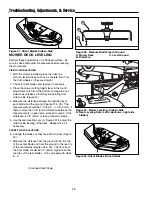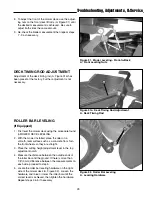
26
Troubleshooting, Adjustments, & Service
Figure 23a. Parking Brake Adjustment
A. Brake Gear (One Each Side)
B. Brake Arm (One Each Side)
C. Brake Rod Adjustment Nut
D. Park Brake Bracket
E. Park Brake Rod
F. Compression Spring
PARKING BRAKE ADJUSTMENT
Brake Adjustment
1. Disengage the PTO, stop the engine, block the front
wheels, remove the ignition key, and lock the motion
control levers into their neutral lock positions.
2. Elevate the rear end of the unit, making sure it is
safely supported.
3. Before attempting brake adjustment, check the brake
gear (A, Figure 23a), brake arm (B), park brake
bracket (D), brake rod (E), and compression spring
(F) for dirt or debris that may affect brake operation.
4. Check to see that the brake arms (B) are engaged
against the brake gears (A), with the teeth on the
arms meshing with the teeth on the gears.
Note: The rear wheels may need to be moved slightly for
the teeth to mesh properly.
5. With the parking brake disengaged (motion control
levers moved from their neutral locked positions),
measure the length of the compression spring (F).
The measurement should be between 2-1/2” and 2-
3/4”. If not, tighten or loosen the brake rod adjust-
ment nut (C) until the correct measurement is
achieved.
C
INCREASE
DECREASE
Figure 24. Front Suspension Adjustment
A. Pre-Load Adjustment Collar
FRONT SUSPENSION ADJUSTMENT
(SELECT MODELS)
The shock assembly can be adjusted to vary the amount
of pre-load applied to the springs. This allows the opera-
tor to customize the ride according to operator’s weight
and operating conditions.
LESS PRE-LOAD:
• Light operator weight
• Softer, more cushioned ride
• Best for relatively flat terrain
MORE PRE-LOAD:
• Heavy operator weight
• Stiffer, more rigid ride
• Better handling and greater stability on hilly terrain
TO ADJUST THE SPRING PRE-LOAD:
1. Park machine on a flat, level surface. Disengage the
PTO, stop the engine and engage the parking brake.
A
B
A
F
E
D
2. See Figure 24. Turn the pre-load adjustment collar
(A) CLOCKWISE to increase the pre-load, turn
COUNTER-CLOCKWISE to decrease the pre-load.
Make sure both shocks are set to the same amount
of pre-load.










































